
views
Finding the Volume of a Solid Object Using a Container of Water

Make sure the object is waterproof before you begin. This method involves submerging the object in the water. If the object is hollow and not watertight, you cannot get an accurate measure of volume using this method. If the object absorbs water, make sure water will not damage it and read the instructions carefully to see how to adjust the process. Never drop an electric or electronic item in water, as this could cause a dangerous electrical shock and/or damage the object beyond repair. If you have access to a vacuum sealer, you may be able to seal a small object in a watertight plastic coating with minimal air inside. This will allow you to get a good estimate of volume since the volume of the plastic used is likely to be relatively small compared to the volume of the object.

Find a container that can comfortably fit the object you are measuring. If you are measuring a small object, you could use a graduated cylinder or measuring cup, which have volume measurements printed on the side. Otherwise, find a watertight container with a volume that is simple to calculate, such as a cylinder or rectangular box. A bowl will not be as accurate, but you can treat it as a cylinder and get an approximate answer, especially if the object is very small compared to the bowl. It's a good idea to locate a dry towel as well, since the object will be dripping water when removed from the container.

Fill it partway with water. Add enough water to submerge the object, but leave plenty of space between the water and the top of the container. If the object has an irregularly shaped base, such as rounded bottom corners, fill it up enough that the water level reaches a more regular portion, such as straight rectangular walls.
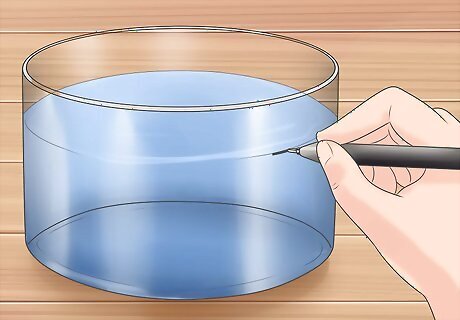
Mark the water level. If the container is transparent, mark the top of the water level on the outside with a wet-erase marker or another easily cleaned writing device. Otherwise, mark the water level on the inside using a piece of colored tape or other mark that will not be washed off by the water. If you are using a graduated cylinder or measuring cup with volume measurements on the side, you do not need to make a mark. Just look for the volume measurement at the water's surface, and write this number down.
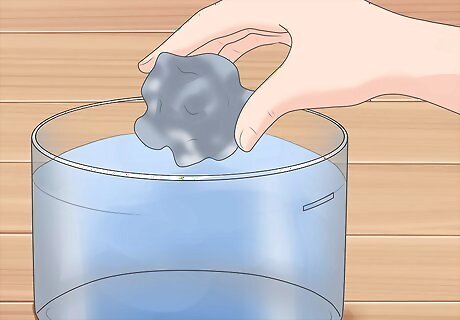
Drop the object into the water and see if it absorbs water. Sink the object you want to measure completely in the water. If the object absorbs water, wait at least thirty seconds for it to absorb the water, then remove the object. The water level should have dropped, since some of the water is in the object. Remove your old mark or piece of colored tape, and replace it with a new one at the new water level. You may then drop the object into the water a second time and leave it there.
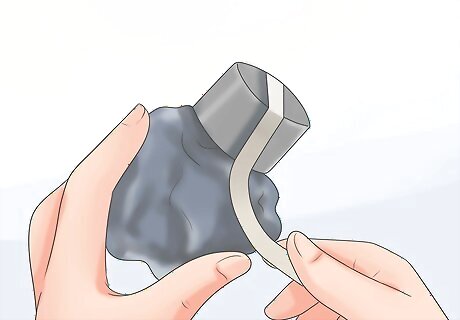
Learn what to do if the object floats. If the object floats, attach a dense, heavy item to it and continue on to measure the volume of both combined. After you write down that result, repeat this method with the heavy item alone to find its volume. Take the combined volume of both items (your first result), then subtract the heavy item's volume. The answer is the volume of the original object. When you take the volume of the heavy item alone, include anything you used to attach it to the original object, such as safety pins or tape.

Make a second mark where the new water level is. If you are using a graduated cylinder or measuring cup, you can write down the volume measurement at the new water height instead. Once you have done this, you can remove your object. You may not wish to leave the object underwater for more than a couple minutes, since even some "waterproof" objects can be affected if left underwater for too long.

Understand why this method works. Since you know the water rose from one level to a higher level when the object was submerged, the volume of space between those two levels is the volume of the object. This is called the displacement method, and works because an object submerged in water always "displaces" an amount of water exactly equal to its volume. Depending on what type of container you used, there are different ways to calculate the volume of this displaced water, which is the same as your object's volume. Finish the problem by continuing on to the step that matches your container's description.
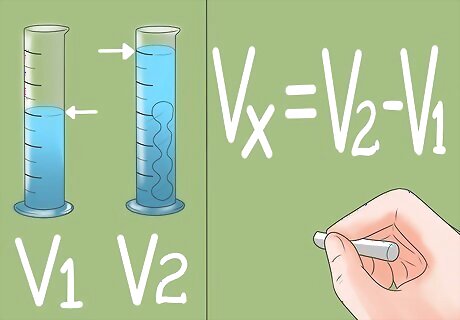
Find the volume using your container's printed measurements. If you used a graduated cylinder, measuring cup, or any other container that has volume measurements printed on the side, you already wrote down the two volumes you need to calculate the answer. Take the volume you wrote down when the object was submerged (the larger volume) and subtract the original volume of the water level (the smaller volume). The answer is the volume of the object.

Find the volume using a rectangular container. If you used a rectangular container, look at the space in the box between the first water mark and second water mark you made. This space forms a "rectangular prism", or box shape, that was filled with the displaced water. Find the volume of this space by measuring the height between the two water marks, then the length and width between the container's inside surfaces. As explained here, you can find the volume of this box-shaped space by multiplying its length, width, and height together (length x width x height). The answer to this multiplication problem is the volume of the object. Do not measure the height of the entire container, just the height from one water mark to another. Use this online calculator or search for another "rectangular prism calculator" that can multiply these numbers for you.
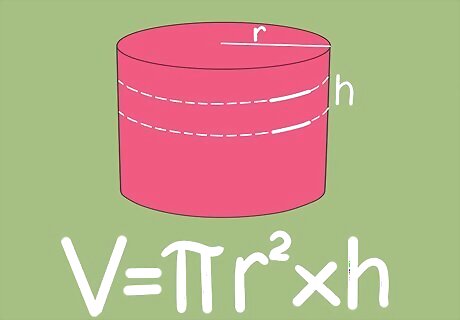
Find the volume using a cylindrical container. If you used a cylindrical container, look at the space between the first water mark and the second water mark. This cylindrical space was once filled with the displaced water, and so its volume is equal to the object's volume. To find the volume of this cylindrical space, you'll need to measure two distances: its height and its diameter. First, measure the height between the two water marks, and write this down. Next, find the diameter of the cylinder by measuring the distance from the inside edge of the cylinder to the opposite side, through the center. Then divide the diameter by two to find the radius, which is the distance from the center of the circle to the edge. Write the radius down, then use your measurements to finish the calculations: Calculate πr, or π x the radius x the radius, to find the area of a circle across the cylinder. If you don't have a calculator with a π button, find one online or estimate by replacing it with 3.14. Multiple your answer by the height between the water marks (which you measured at the beginning of this step) to find the volume of space the water took up. This answer is also the volume of your object. You can get a more precise answer, or save yourself some math, if you enter your measurements on an online cylinder volume calculator.
Calculating the Volume of an Irregular Object in a Word Problem
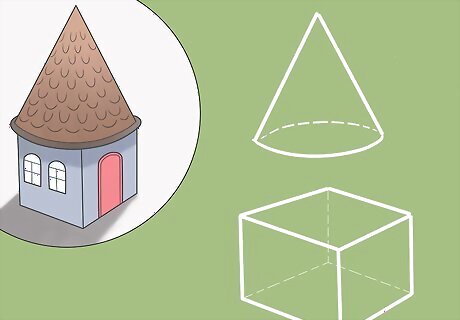
Break down the object into more regular shapes. If a word problem describes an irregular object and asks you to find its volume, you are probably expected to break it up into sections. The word problem may hint at this by describing the object as, for instance, "a cone on top of a cube," or you may have to figure out from a diagram how to divide it into objects with easier shapes to measure. Look for places where the irregular object is joined together at an unstated angle (not 90º). Can you "cut it apart" at that angle into two objects that have names, such as cylinders or pyramids? These do not have to be the same object.
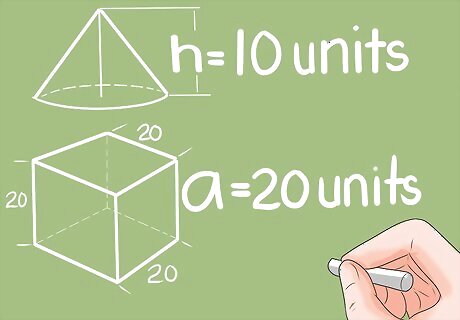
Write down the measurements of each section. To find the volume of a cube, rectangular prism, or pyramid, you'll need to know its length, width, and height. To find the volume of a cylinder or cone, you'll need to know its radius and height. Read the word problem carefully and write down the measurements of each section, carefully labeling them or drawing a diagram of each section with the measurements written on it. If the word problem tells you the diameter but not the radius, divide the d iameter by two to get the radius. You may need to do some addition or subtraction to find the measurements you need. For instance, say the problem tells you "a building shaped like a cone on top of a cube has a height of 30 units, but the height of the cube section is only 20 units tall." The height of the cone isn't listed, but logically it must be 30 units - 20 units = 10 units.
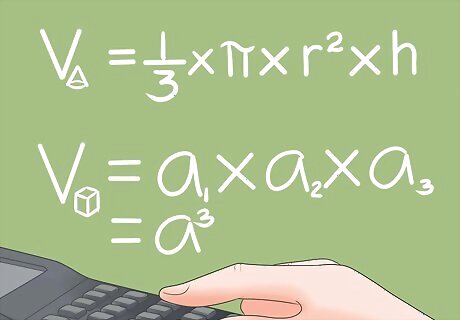
Calculate the volume of each section. Use the more common volume formulas for regular objects to find the volume of each section. Write down the result of each calculation and label it so you don't forget which section you've already calculated. If you need a refresher on how to calculate volumes, see these instructions for common shapes.

Add each result together. Once you've calculated the volume of each section separately, add every result together to get the volume of the entire object. Reread the word problem to make sure you didn't forget anything. If everything checks out, congratulations: you have found the answer.













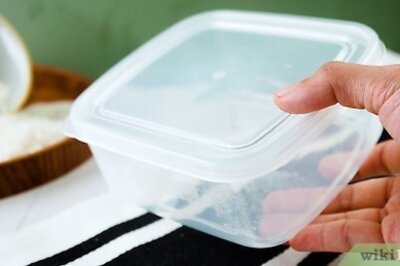




Comments
0 comment